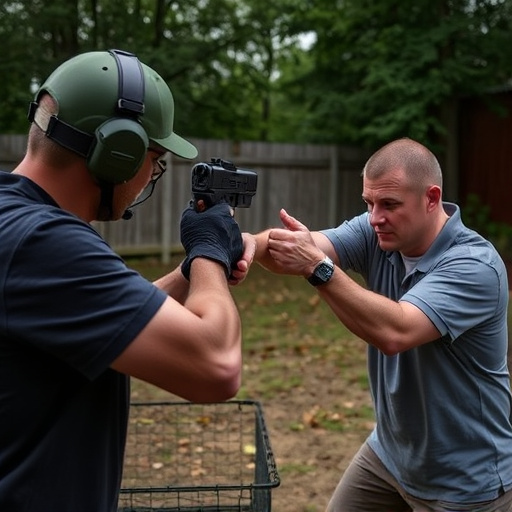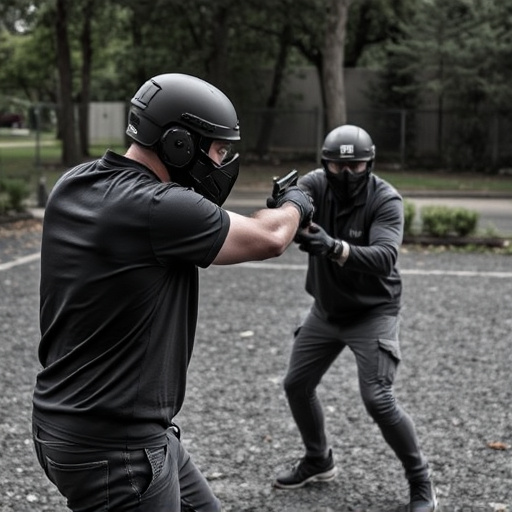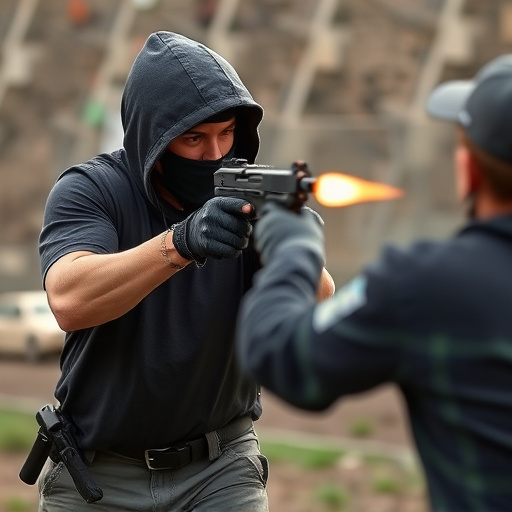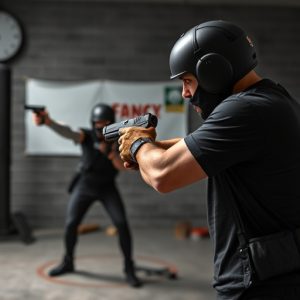Optimal Electrode Spacing: Unlocking Stun Gun Effectiveness for Self-Defense
Choosing the best-rated stun guns for self-defense involves understanding electrode spacing and powe…….
Choosing the best-rated stun guns for self-defense involves understanding electrode spacing and power delivery. Stun gun electrodes disrupt an assailant's nervous system, with strategic placement and spacing enhancing shock effectiveness while minimizing user risk. Key factors include voltage output, pulse width, weight, and safety mechanisms like motion sensors. Top models offer ergonomic designs for quick deployment, with advanced settings catering to diverse self-defense scenarios. Proper electrode spacing ensures powerful yet controlled shocks, making best-rated stun guns a reliable tool for personal safety in various environments.
“Uncover the critical factor influencing the power and effectiveness of your stun gun: electrode spacing. This comprehensive guide explores how the strategic placement of electrodes in top-rated stun guns enhances shock delivery, making them indispensable tools for self-defense.
From understanding the science behind electrode spacing to reviewing best-in-class stun guns on the market, this article equips readers with insights into choosing the right device for optimal safety and self-protection. Discover how electrode design impacts performance, and gain real-world perspectives on their effectiveness in defensive scenarios.”
- Understanding Stun Gun Electrode Spacing: Key to Effective Shock Delivery
- Best-Rated Stun Guns on the Market: A Comprehensive Overview
- How Electrodes Affect Stun Gun Performance and Power
- Safety Considerations: Choosing a Stun Gun with Optimal Electrode Placement
- Real-World Applications: Effectiveness of Stun Guns in Self-Defense Scenarios
Understanding Stun Gun Electrode Spacing: Key to Effective Shock Delivery

Understanding Stun Gun Electrode Spacing is paramount in ensuring effective shock delivery, especially when it comes to self-defense tools like best-rated stun guns. The electrode spacing refers to the distance between the positive and negative terminals of a stun gun’s probes, designed to disrupt an assailant’s nervous system. Optimized spacing ensures that the electric current flows efficiently through the target, causing muscular paralysis and disorientation.
Manufacturers carefully consider this factor when designing stun guns, focusing on electrode configurations that maximize impact while minimizing risk of injury to the user. For instance, some models feature closely spaced electrodes for enhanced effectiveness during close-quarters encounters, while others have more spread-out designs suited for long-range situations. Choosing a stun gun with appropriately configured electrodes can significantly improve its performance in real-world scenarios, making it an indispensable asset for personal safety, particularly when relying on self-defense mechanisms.
Best-Rated Stun Guns on the Market: A Comprehensive Overview

When it comes to choosing the best-rated stun guns for self-defense, several factors come into play. Top-tier models boast powerful electric currents that can incapacitate attackers while ensuring user safety through smart design and advanced features. Key considerations include voltage output, pulse width, weight, ease of use, and durability.
Among the best-rated stun guns on the market, you’ll find devices with outputs ranging from 10,000 to 15,000 volts, designed to deliver a strong enough shock to disable an assailant temporarily. Some models feature advanced safety mechanisms like motion sensors and automatic shut-off features, making them ideal for self-defense in various scenarios. Lightweight designs and ergonomic grips enhance usability, ensuring users can deploy the stun gun quickly and effectively during emergencies.
How Electrodes Affect Stun Gun Performance and Power

The placement and spacing of electrodes on a stun gun play a significant role in its overall performance and power delivery. Stun guns use electrical current to disrupt muscle control, causing an individual to lose mobility and balance. Electrodes act as the entry points for this electric current, so their arrangement matters greatly. Best-rated stun guns for self-defense often feature strategic electrode positioning to ensure maximum impact.
Close and precise electrode spacing allows for a more concentrated flow of electricity, increasing the likelihood of a successful stun. Wider gaps between electrodes can distribute the electrical charge over a larger area, potentially reducing the intensity but still providing an effective deterrent. The best configuration strikes a balance between coverage and focused delivery, ensuring the stun gun is both powerful and versatile enough for various self-defense scenarios.
Safety Considerations: Choosing a Stun Gun with Optimal Electrode Placement

When considering a best-rated stun gun for self-defense, safety should always be the top priority. One critical aspect to look out for is the electrode spacing on the device. Properly positioned electrodes are essential to ensure effective shock delivery and minimize risks. Stun guns with well-designed electrode placement aim to deliver a powerful jolt while avoiding accidental shocks or damage to nearby tissues.
Optimal electrode spacing ensures that the stun gun’s current flows directly through the attacker, minimizing collateral damage to bystanders or innocent parts of the body. This is particularly important for personal safety when using self-defense tools. Modern stun guns often come with advanced features, including adjustable settings and intelligent design, to cater to different user needs and ensure safe operation.
Real-World Applications: Effectiveness of Stun Guns in Self-Defense Scenarios

In real-world applications, stun guns have proven to be effective tools for self-defense. When it comes to the best-rated stun guns for self-defense, electrode spacing plays a crucial role in their overall performance. A well-designed stun gun with optimal electrode spacing can deliver a powerful shock that temporarily disables an assailant, providing valuable time for escape or help.
In self-defense scenarios, the effectiveness of a stun gun is often measured by its ability to subdue an attacker quickly and safely. The spacing between the electrodes directly influences the electrical current’s penetration and distribution on the target. Properly spaced electrodes ensure that the shock is delivered efficiently across a broad area, maximizing the disruption of the assailant’s nervous system. This strategic design makes stun guns a reliable option for individuals seeking personal safety in various situations, from home protection to outdoor adventures.
When it comes to choosing the best-rated stun guns for self-defense, understanding electrode spacing is crucial. This article has explored the impact of electrode placement on stun gun performance and safety. By ensuring optimal electrode spacing, users can maximize the effectiveness of their stun device in real-world scenarios, providing a powerful tool for personal protection. Among the top-rated models available, careful consideration of electrode design will contribute to the overall success in deterring and disabling attackers.


